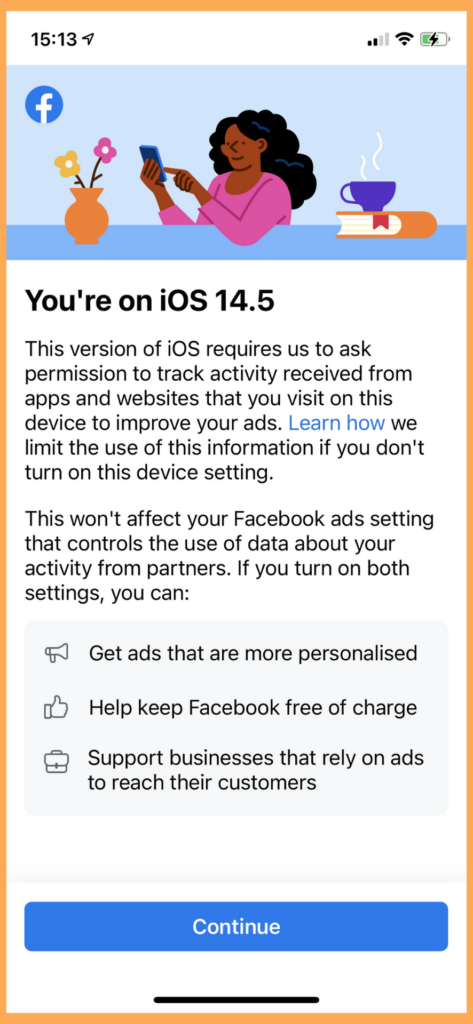Facebook is the long-reigning king of modern social media. By the end of 2020, Facebook reported an average of 1.84 billion Daily Active Users (DAUs) and 2.8 billion Monthly Active Users (MAUs) – an increase of 11% and 12%, respectively, year-on-year. These numbers far exceed the MAU of other social media platforms, with Instagram (owned by Facebook) the closest at 1.2 billion MAUs. While every platform has its perks, Facebook ads allow you to cast the widest net in terms of audience reach and targeting. Facebook ads, however, may be affected by the new iOS 14 update for Apple iPhones.
iOS 14 – What’s changed?
In a nutshell, starting with iOS 14.5, iPad OS 14.5 and tvOS 14.5, app developers and businesses need to obtain explicit permission from users to track their activity across other devices, websites, and apps. The default option is to allow apps to request to track a user, meaning users will see prompts to allow tracking when they next open their favourite apps after the update.
How does the iOS 14 update affect Facebook ads?
Are you in or out?
Users of the Facebook iOS mobile app will see the below prompt when opening the app after the update, where they may opt-in or out of cross-website/app tracking on their device. Facebook’s prompt for tracking requests is transparent and lets the user know that developers/companies are now required to ask for permission to track data. Facebook state that allowing tracking across devices will mean the user will: see more personalised ads; help support Facebook and keep it free of charge; and support businesses that rely on ads to reach their customers.

While privacy tools have been integrated into iOS before, this is considered a major update for privacy on Apple devices that users have been wanting. However, it has negative knock-on effects for businesses running ads online that rely on tracking data to target specific audiences.
Problems you may experience due to the iOS 14 update
Audience targeting limitations
Running on the assumption that a large number of Apple users will opt out of tracking, the way Facebook collects data will change. According to Facebook, “businesses that advertise mobile apps, as well as those that optimise, target and report on web conversion events from any of our business tools will be affected.”
As more devices are opted out of tracking, you may see a decrease in the size of your app connections, app activity Custom Audiences, and website Custom audiences. Unfortunately, it’s estimated that without campaigns and personalised ads powered by their own data, “small businesses could see a cut of over 60% of website sales from ads.”
Reporting limitations
Delayed data
There will no longer be support for real-time reporting, and data may be delayed up to three days. For iOS 14 App Install campaigns, “conversion events will be reported based on the time that they are reported to Facebook by the SKAdNetwork API and not the time they occur.” Meanwhile, web conversions will be reported based on the time of the conversion event rather than on the timing of the associated ad impression.
Estimated results and no breakdown support
For app install campaigns on iOS 14, “the SKAdNetwork API will report results to Facebook, aggregated at the campaign level,” meaning estimated results at the ad set and ad levels unless the campaign only contains one ad set and ad.
Delivery and action breakdowns – “such as age, gender, religion, and placement” – will no longer be supported for both app and website conversions.
What you need to do
Verify your domain
Under Facebook Business Settings > Brand Safety > Domains, you can claim ownership of your domain through domain verification. This allows you to control the editing privileges of your links and other content to prevent misuse of your domain, and help avoid any future disruption of your website campaigns.
So, if you plan to run ads that optimise for conversion events that occur on your business’ website, you’ll need to verify your domain. There are three methods to do this:
- Add a DNS TXT entry to your DNS record to confirm that you own the domain,
- Upload an HTML file provided by Facebook to your web directory and confirm domain ownership in Business Manager,
- Add a meta tag to the <head> section of your domain home page.
This must be done for the effective Top-Level Domain plus one (eTLD+1), and there is support for domains already registered with the Public Suffix List. Prioritise domains that utilise pixels that are “used by multiple businesses or personal ad accounts.”
Configure the Aggregated Events Measurement (AEM)
Facebook’s Aggregated Event Measurement allows you to choose up to 8 standard events and custom conversions that can be used in your campaign for optimisation. These should be selected from highest to lowest priority – for example, if your objective is sales, your highest priority event would be a purchase.
Unsupported Events
If you try to optimise for a website conversion event that isn’t part of the 8 prioritised website conversion events set for your domain, the campaign’s ad set will be turned off and unable to be turned back on. You will have to create a new ad set and choose from one of the events that you’ve already prioritised within the Events Manager.
Monitor your audience sizes
As changes are still happening and more people are changing their tracking settings, you should keep a close eye on your Facebook ad audience sizes. You are likely to see a decrease in audience sizes and inconsistent results for a little while before things settle down.
It’s also a good idea to focus on in-Facebook targeting during this time, such as using the video views objective or a custom audience made from users who have engaged with your page. Facebook ad campaigns that don’t rely on external website/app conversion data are likely to have better results while the iOS 14 changes to Facebook ads settle down.
For full details and Facebook’s perspective on the iOS 14 update, read their help post (also referenced throughout this article).





